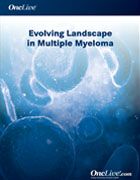Publication
Video
Supplements and Featured Publications
Dr. Raje on Data With AMG 420 in Multiple Myeloma
Noopur Raje, MD, director, Center for Multiple Myeloma, Massachusetts General Hospital Cancer Center, and professor of medicine, Harvard Medical School, discusses data with AMG 420 in multiple myeloma.
Noopur Raje, MD, director, Center for Multiple Myeloma, Massachusetts General Hospital Cancer Center, and professor of medicine, Harvard Medical School, discusses data with AMG 420 in multiple myeloma.
Several novel bispecific T-cell engagers (BiTEs) are in development in multiple myeloma, says Raje. The drug that’s the furthest along in development is AMG 420, which is an off-the-shelf product. In vivo, the agent targets BCMA; it has a different linker which activates a patient’s T cells that then target the malignant myeloma cells and kills them.
The drug has shown remarkable responses in patients with heavily relapsed/refractory myeloma, leading to minimal residual disease (MRD) negativity. Additionally, some patients are on the drug for close to 1 year, says Raje. However, AMG 420 is a short-acting BiTE, so it has to be given continuously; this can make it challenging for patients because they have to wear a pump in order to receive the drug.
Another BiTE that is being developed by Celgene has been shown to lead to MRD negativity in patients. The difference between this BiTE and the Amgen BiTE is that it’s longer acting; therefore, it doesn’t have to be given as an infusion. Investigators are also working on developing a subcutaneous formulation that could make it easier to administer, concludes Raje.










